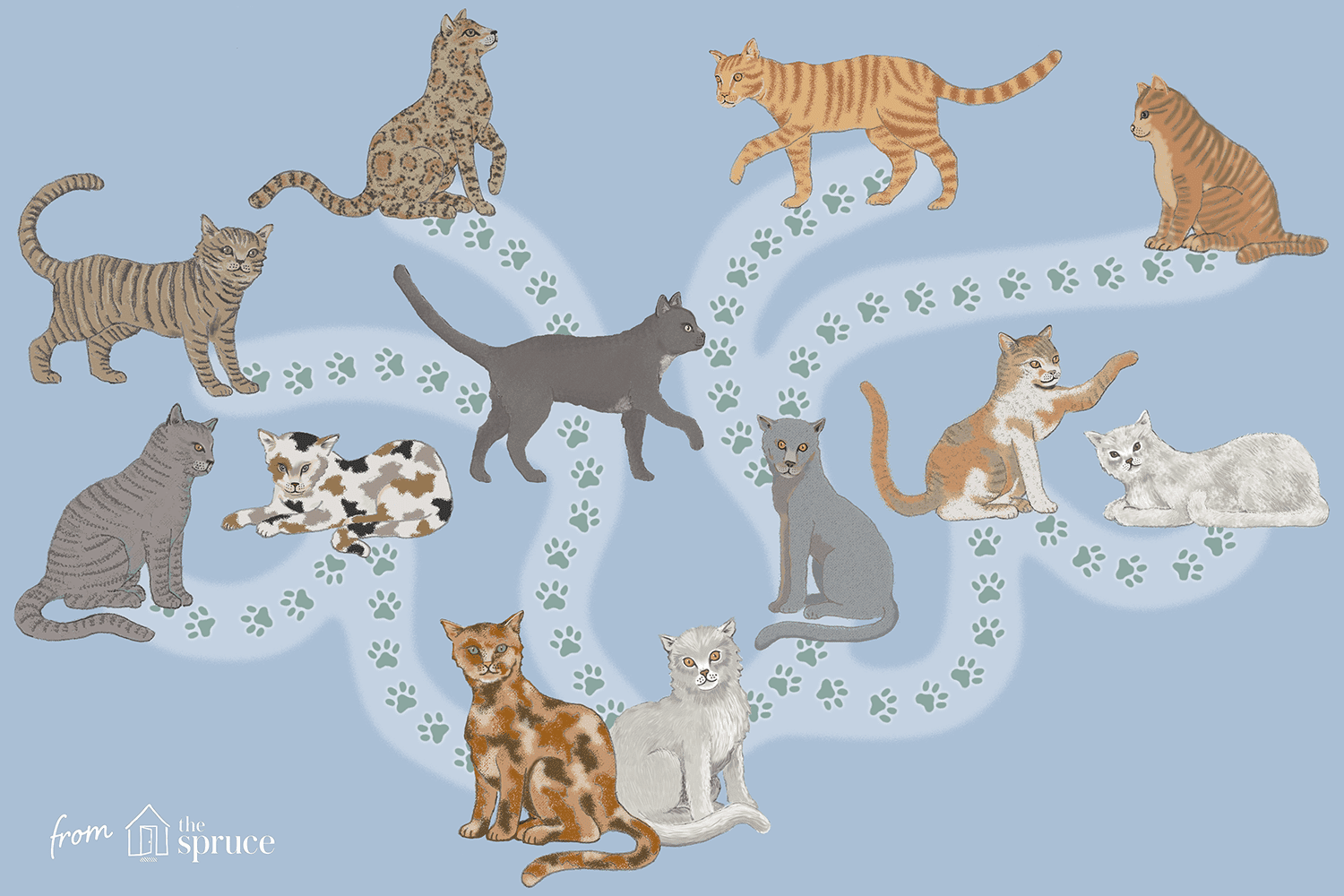No, unless you have papers proving your cat’s pedigree, your cat is likely not a pure breed. Most house cats are considered domestic short-haired, domestic medium-haired, or domestic long-haired cats and are not pure breeds.
However, there are ways to assess a cat’s purity through pedigree papers and physical characteristics. DNA tests can also provide more insight into your cat’s breed heritage.
Understanding Purebred Cats
Want to know if your cat is a pure breed? Check for pedigree papers, physical traits, and breed standards to determine their purity.
Defining Purebred Cats
A purebred cat is a cat that comes from a lineage of cats of the same breed, with both of its parents belonging to the same breed. Purebred cats are known for their distinct physical characteristics and specific breed standards. These characteristics and standards are set by cat associations and breed registries that govern purebred cat breeds.
Identifying Purebred Cats
Identifying whether your cat is a purebred involves examining its physical features and comparing them to the breed standards. Purebred cats usually have unique coat colors, patterns, and textures that are specific to their breed. They may also have specific body shapes, eye shapes, and ear shapes that are characteristic of their breed. However, it is important to note that not all cats with these features are necessarily purebreds, as some mixed-breed cats can also exhibit similar traits.
Methods For Determining Purebred Status
There are several methods for determining the purebred status of a cat:
- Pedigree Papers: One common way is through pedigree papers, which provide a documented lineage of the cat’s ancestors. These papers authenticate the cat’s lineage and confirm its purebred status.
- Physical Characteristics: Physical characteristics and breed standards can be used to assess a cat’s purity. These standards outline the ideal physical features and traits that a purebred cat of a specific breed should possess.
- DNA Testing: In some cases, DNA testing can be used to determine a cat’s breed. Cat DNA tests can provide in-depth information about a cat’s genetic composition and lineage.
It’s important to note that while these methods can provide some insight into a cat’s purebred status, they are not foolproof. It is always recommended to consult with a professional or a cat breed expert for a definitive answer.

Credit: www.catster.com
Characteristics And Behaviors Of Purebred Cats
Purebred cats often display distinct characteristics and behaviors that set them apart from mixed-breed cats. These characteristics can vary depending on the specific breed, but they provide valuable insights into a cat’s lineage and heritage. By understanding the physical characteristics, temperament, and common health issues of purebred cats, you can gain a deeper appreciation for your feline friend’s breed and enhance the bond you share.
Physical Characteristics
Each purebred cat breed has its own set of unique physical characteristics. These traits can include a specific body shape, size, coat color, and pattern. For example, the Scottish Fold breed is known for its distinctive folded ears, while the Siamese breed is recognized for its elegant, muscular body and striking blue eyes. Here are some examples of physical characteristics of popular purebred cat breeds:
| Breed | Physical Characteristics |
|---|---|
| Ragdoll | Large size, semi-long fur, blue eyes |
| Maine Coon | Large, muscular build, tufted ears, bushy tail |
| Persian | Round face, short nose, long, dense coat |
Temperament And Personality Traits
Purebred cats also often have specific temperament and personality traits that make them unique. Breed standards can provide insights into their behavior and preferred interaction styles. For instance, the Siamese breed is known for its affectionate and vocal nature, while the Bengal breed tends to be active and lively. Here are some examples of temperament and personality traits commonly associated with purebred cat breeds:
- Ragdolls: Gentle, docile, and affectionate
- Sphynx: Playful, social, and energetic
- Persians: Calm, laid-back, and independent
Common Health Issues
While it’s essential to appreciate the unique characteristics of purebred cats, it’s also crucial to be aware of their potential health issues. Some purebred cats are more prone to specific genetic conditions or breed-related health problems. By understanding these common health issues, you can take steps to care for your cat’s well-being effectively. Here are a few examples of common health issues seen in purebred cats:
- Maine Coon: Hypertrophic cardiomyopathy, hip dysplasia
- Persian: Polycystic kidney disease, respiratory problems
- Bengal: Progressive retinal atrophy, patellar luxation
It’s important to note that not all purebred cats will develop these health issues, but being aware of them can help you monitor your cat’s health and seek appropriate veterinary care when needed.
Finding Out If Your Cat Is A Pure Breed
If you’ve ever wondered if your cat is a pure breed, you’re not alone. Many cat owners are curious about their feline friend’s lineage and heritage. While determining a cat’s breed can sometimes be a challenge, there are a few ways to find out if your cat is indeed a pure breed.
Pedigree Papers And Lineage Confirmation
One common way to confirm if your cat is a pure breed is through pedigree papers. Pedigree papers are official documents that authenticate a cat’s lineage and confirm its purebred status. These papers are typically obtained from reputable breeders and provide detailed information about the cat’s parents, grandparents, and beyond.
When assessing the authenticity of pedigree papers, it’s important to verify the credibility of the breeder and ensure that they are recognized by reputable cat breed organizations. These organizations maintain breed standards and regulate breeding practices to ensure the integrity of purebred cats.
Physical Cues And Dna Testing
Aside from pedigree papers, another way to determine if your cat is a pure breed is by looking for physical cues and characteristics associated with specific breeds. Breed standards outline the desired traits and characteristics of each breed, such as coat color and pattern, body shape, ear shape, and eye color.
If your cat closely resembles the physical characteristics of a specific breed, it may indicate that they are indeed a pure breed. However, it’s important to note that physical cues alone may not always provide conclusive evidence of a cat’s breed, as there can be variations within a breed.
In cases where physical cues are not sufficient, DNA testing can provide more accurate information about your cat’s breed. Cat DNA tests use a cheek swab to obtain your cat’s DNA, which is then analyzed to determine its genetic heritage. These tests can reveal the presence of specific breed markers and provide insights into your cat’s lineage.
Considerations For Shelter Cats
If you have a cat that was adopted from a shelter, determining their breed can be a bit more challenging. Shelter cats often have mixed heritage, making it difficult to pinpoint a specific breed.
However, there are still some visual cues and physical characteristics that can provide clues to your cat’s breed. These include coat color and pattern, body shape, ear shape, and eye color. While these cues may not indicate a pure breed, they can give you a general idea of your cat’s heritage.
For those curious about their shelter cat’s breed history, there are DNA tests specifically designed for cats that can provide more insight into their genetic makeup. These tests can identify the presence of specific breed markers and give you a better understanding of your cat’s unique genetic background.
:max_bytes(150000):strip_icc()/black-white-cat-on-lap-dpddm-JD-913-2000-9ba4ae3a902544d88af9f7ded6d7fe0c.jpg)
Credit: www.dailypaws.com

Credit: petguin.com
Frequently Asked Questions Of Is Your Cat A Pure Breed?
How Can You Tell If Your Cat Is Purebred?
To determine if your cat is purebred, look for pedigree papers that authenticate its lineage. You can also assess its physical features and compare them to breed standards. Consider using a cat DNA test for more accurate results.
What Kind Of Breed Is Your Cat?
To determine your cat’s breed, you can use pedigree papers, examine physical characteristics, and assess breed standards. Another option is a cat DNA test, which provides detailed information about lineage and genetics. Visual cues like coat color, body shape, ear shape, and eye color can also give clues about your cat’s breed.
What Does Breed Mean For Cats?
The breed of a cat refers to a specific set of physical characteristics that the ideal cat of that breed should have. It helps determine the lineage and purity of the cat. Common ways to identify a purebred cat include pedigree papers, physical traits, and breed standards.
How Do You Know If Your Cat Is A Special Breed?
To determine if your cat is a special breed, look for visual cues like coat color, pattern, body shape, ear shape, and eye color. Pedigree papers can also authenticate a cat’s lineage. For certainty, you can use a DNA test specifically designed for cats.
Conclusion
Determining whether your cat is a pure breed can be a fascinating journey. You can look for pedigree papers and examine physical characteristics to confirm their lineage. There are even DNA tests available to provide in-depth information on your cat’s breed heritage.
While most house cats are not pure breeds, they still share common ancestry with certain cat breeds. So, whether your cat is a pure breed or not, their unique traits make them special and lovable companions. Embrace the diversity and uniqueness of your feline friend!

